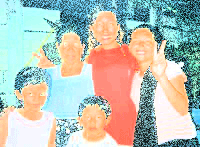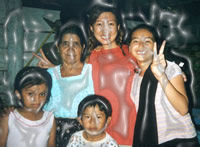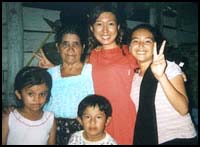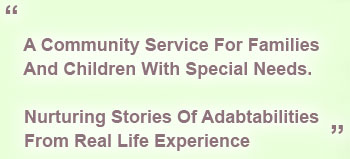Part III
SHARED ACTION-TAKING
LINKING AND RECONNECTING TO
NATURAL AND COMMUNITY SUPPORTS
- A. Gathering the Family Together
- B. Attachment Relations
- C. Building a Dyad to Help Problem-Solve
- D. Gathering More Helping Persons
- E. Networking
- F. Telephone Conferences
- G. School and Small Group Consultation or Conferencing
- H. Gathering A Multi-systemic Core Team
 Download Part III
Download Part III
Creating contexts for change involves coming together in the service of health and learning. People use methods of coming together as interpersonal bridges to reciprocal exchange and mutual support. When being together we see that something bigger is at stake than our individual selves, we create connections with heartfelt meaning, direction and purpose. People need each other. We need to connect in a way that matters to connect and reconnect to husbands, wives, brothers and sisters, partners, friends, neighborhoods and communities bringing together our traditions, stories, pasts and future aspirations, hopes and dreams. (Hallowell, 1999)
The ABLE staff proposes ways to build connections, with such goals as family unity, child attachment, finding a friend, and forming allies as discussed in this section. Methods involved in obtaining these goals are summarized below. These Methods are stated under the following titles: Listening and Talking, Social Outcomes from A Sense of Belonging, Connections Buffer Losses, Goodness of Fit is Relational.
| [Back to Top] |
Listening and Talking
 |
With a spirit of connection, we use the knowledge and skills from Our Practices – Part I under the menu For Professionals, to enhance communication and exchange ideas and information. Both of these sections fit together to include active listening, creating a cooperative atmosphere, and initiating interest and curiosity among each other. They are most required when several persons get together to talk with each other. We also reflect back on previous Under the menu For Professionals – Our Practices – Part I and Our Practices – Part II for the process and content needed for cross cultural communication using the various ethnographic, motivational, solution-oriented, narrative and change-based practices.
Social Outcomes from A Sense of Belonging
 |
When referral resources are presented within the fold of safe connections and community linkages, a more adaptive functioning of the client, family, and peers can result. The client/family now begins to experience an anticipation of healing and repair. The family also may begin to experience increased coping abilities, a felt sense of internal control and strength, as well as a growing sense of competence and empowerment. Further experiences are fostered by these opportunities to come together for shared mastery and interdependence. Such mutually-felt experiences help buffer the adverse effects of the client/family’s emotional and physical world, and stimulate resilience building. These optimal reconnecting moments may be felt in part during mentorship, friendship building, and the promotion of such positive activities and events as group recreation, service projects, and esteem building. Such engagements begin to enhance mutual attachment, social bonding, and relations between caregiver and child sometimes by getting the family to simply talk to each other more often.
| [Back to Top] |
Connections Buffer Losses
 |
Shared listening, and the witnessing of family stories are tools used to help a family move toward health. When there has been a wrong committed, opportunities are assessed for restitution from victimization that has occurred through injustice and inequity. Through a sense of belonging, stigma and feelings of difference, shame and alienation can be lessened. The family members’ roles and rituals are normalized through emphasizing expected everyday events. This helps protect, nurture and re-establish rightful ownership of a family’s preferences and actions. Social and psychological core needs of trust, power, autonomy, competence, initiative, and intimacy are also attended by the weft and warp?, and woven into the fabric of family stories to give origin to personal qualities, which are the grist for resiliency. In community, the client/family feels increasingly recognized, accepted, valued, and able to count on those closest to them.
Positive change, even if just a small step, is seen in a variety of ways, and may even be manifest by the mere containment or minimization of the previously-severe and complex family situations. With multi-stories of client/family reunion may also come the process of resolving or ameliorating conflicts and frustration over the parent’s previous perceptions of loss and broken dreams. Intangible or symbolic losses or threats of separation, stress-laden pain, grief and disenfranchised mourning are eased through a collective grieving and healing. The social group may mitigate the hurt and succor the wounds helping the client/family through mourning the loss of the idealized child and other losses.
| [Back to Top] |
Goodness of Fit is Relational
 |
Family stories, told and retold, can gradually describe a more congruent match or “goodness of fit” between parents’ expectations and their child’s capacities, as well as the family’s expectations and the community’s responsiveness. The team continually recognizes that growth and healing are taking place. Social stories are developed with an appreciation of the strength and abilities of the child, family and school. This task requires the team’s unqualified acceptance, positive regard, and heightened affirmations, resulting in the mirrored sources for the child and family being heard, seen and felt, so that the family may provide a more optimal attachment when supported by the multiple supportive relationships around them. The team strives to convey and instill hope and positive expectations from new perspectives and meanings gathered from the social network. It is the renewed dream that is most likely to foster greater courage and continued healing.
Action Steps Toward Connections
 |
| [Back to Top] |
A. Gathering the Family Together: (See Family Global Health and Well-being Scale Form – a family relationship rating scale).
It is in families where basic relationships generally start. However, acknowledging that serious problems often develop in families, discussion follows on utilizing community people and resources that can model successful meeting formats that families can later use in resolving problems within their own domains. From the sharing opportunity in group meetings, families can look forward to applying what they learned back in their natural settings. (See A Model for Family Meetings Handout)
A child’s relationship with an adult caregiver might also be enabled by a social support network allowing special time between them again (See Enhancing Family Functioning Handout). This may also be the basis for acquiring a mentor, big brother/sister or a buddy connection.
C. Building a Dyad to Help Problem-Solve:
“Two heads are better than one”.Recruit one or two family members or good friends as you further look for support. A parent exploring solutions to a problem with a child will be better managed if the parent doesn’t have to be alone in the task. Solutions will likely come initially from just talking with another person. The more that couples can communicate with each other, the stronger their collective efforts. A grandparent or a church friend might also be available. Start with a phone call to discuss needs, ideas and goals. Ask this person if he or she might be willing to go to a school meeting with you sometime. Parents willing to help other parents may also be available through such support groups as the proposed Utah Family-to-Family Networks of DSPD or the Utah Parent Center. List Serves or protected on line support groups and chat groups are also accessible. Go to Advocacy and Support for more information.
| [Back to Top] |
D. Gathering More Helping Persons:
 |
 |
 |
 |
 |
A common and recurrent theme from previous parts is that of gathering all the appropriate people involved in the problem or its solution. These people may include family members, extended family, friends, teachers, administrators, a health provider, a psychologist, a social worker and others as needed (See Family Support Chart). An alternative to this method might be constructing a Family or Eco-Genogram (See the Four Generation Family Genogram Handout) in order to show the multiple relations and how resources configure into these family-community relationships.
“When the heart stops beating, the blood no longer carries oxygen, nutrients and wastes to various body parts, and death occurs. Even so, when there is little or no communication between persons, the relationship dies.” Care Coordination is a form of service that enables parents and medical folks to talk about chronic and complex health problems and needs allowing multiple providers to keep the big picture in focus. Here they share in assessments, communicate needs and progress, and also share in identifying resources as well as case management. See the Medical Home School Services Recommendation Form (Form for Evaluation and Service Recommendations -40 kB PDF Document).
[Back to Top]
Holding A Brief Meeting
 |
- Getting Ready:Think about a purpose for the meeting. Who do you want to attend? We recommend focusing primarily on the people who may have something to do with the problem, i.e., the problem-organizing team. There may be additional players who can also offer solutions. Learn to relax and reduce your tensions at the meeting. If the child can’t be there, you may want to have some reminder of him or her on the table and perhaps a short tape of what the child says is hard for him or what he likes to do. Learn to negotiate and see the point of view of the others. Remember, you are learning advocacy skills and may be the only one willing to stand up for your child. (A good reason for bringing a friend or other family member to the meetings!)

- Addressing Given Concerns, with an Outcome Focus: What are the problems? What are the goals? What are the solutions? Is there a step-by-step plan? Sometimes problems need solving by means of first understanding their root causes. A statement of problems can be rewritten in a positive way and become a goal. The solution-focused approach is an inductive method that bypasses the more familiar Western problem-analysis approaches which are deductive, logical and problem-solving. If that doesn’t work, other solutions may encourage more progress. See Solution Focus Handout or see Steps to Follow in Collaborative Coordination Handout.
- Assignments, Follow-up, Maintenance and Transition: Notes should include in a written record the people present, the background situation, observations, health situations, strengths, concerns and plans noting who is responsible for carrying out what, and when, and finally, a date for a follow-up meeting or telephone conference. Unless accountability is included, goals are not likely to be obtained. See Family Health Promotion Plan.
 |
| [Back to Top] |
(Optional) Here, a group of health professionals, such as a physician, a psychologist, a social worker and a nurse gather around a speakerphone and discuss problems and solutions with a teacher or group of school personnel who are also sitting around a speakerphone or other conferencing tool. Telephone conferences are useful when an essential person is not otherwise available in person. By this means, shorter response times are possible and greater flexibility is afforded. We find this to be a way of connecting through auditory attunement, but it may require knowing the parties from previous face-to-face meetings. We try to make these sessions efficient, and focus the participants toward goal-definition and accountability in a context of positive regard witnessing what the child-family has made work for themselves. We also look forward to the time when video-teleconferencing and video-streaming will be more available and familiar for even further conference options.
 |
| [Back to Top] |
G. School and Small Group Consultation or Conferencing:
These are meetings to improve an at risk child’s school experience as well as provide ways to partner and participate. These joint efforts develop strategies, and are generally composed of a teacher, a resource teacher, a counselor, the principal, possibly a health representative (if not in person, then with information obtained earlier perhaps by phone), a parent, a parent advocate, and maybe a school district representative. The child may also be invited in a way to help him feel comfortable, such as with a friend, a pet or a favorite item. A School and Community Conference Form should be completed. This would include names of those attending, background concerns, medical concerns, observations, strengths, plans and who will carry them out, and a follow-up meeting date. Sometimes the health provider will need to submit his or her input in alternative ways, as mentioned above, using the Med Home School Evaluation Recommendations form under Schools and Education in the Medical Home website. The form offers ample opportunity for communication so the team may share important information. It also gives instruction on the best way to make contacts, a description of the medical conditions and their impact on function, along with other ideas and concerns. It would be important to achieve two-way communication with the health provider using alternative ways if necessary, when diagnoses are multiple and complex.
Guide to Conferencing
| [Back to Top] |
 |
Conferencing is a tool available to most any school or other service, and generally without any additional budgetary costs! Locally, it is utilized along the Wasatch Front and other parts of Utah in cooperation with the ABLE Team of the State Health Department. Conferencing can be a means of acquiring additional information in a multi-disciplinary setting. For example, parents of a child with an IEP can ask for a conference meeting which could include providers beyond school personnel, as a parent has authority to request. This model, generally conducted in a school setting, offers the following options:
- Challenges, needs and concerns are identified and discussed.
- Members are non-blaming, and promote respect and affirmation of each participant’s role.
- It facilitates a coping process among those concerned.
- It identifies the balance between the child’s risks and positive capacities or strengths.
- It offers assistance in containing the challenges.
- It assesses needs and resources.
- It consciously works to limit the negative consequences.
- It delegates interventions that would be difficult for any one person to accomplish.
Principles and Values Recognized in School Conferencing:
- Using what is available.
- Recognizing that “There is strength in numbers”.
- Listening to and acknowledging “Family Stories”.
- Bringing together several views.
- Sharing of conversation from partnerships, serving as a catalyst for change.
- Helping to secure the most accurate perceptions.
- Exploring and expanding choices and decision-making.
- Offering many hands lightening overwhelming and complex work.
New Child and Family Conference Outcomes:
- From identified strengths, resources and supports, interventions are developed and carried out.
- Parent/school partnerships and bonding help establish family-school identity and a sense of belonging for the child.
- Conferences provide ways and means to evoke self-motivation toward change action, as well as for measuring progress.
- Conferences offer an informal first glimmer of hope and strength for families and school.
- They also develop and acknowledge stronger family-school voices.
| [Back to Top] |
Group Composition:
 |
The criteria used in forming a conference team for a high-risk student is to informally gather a group of key people already identified and valued in the life of the child and family. The team is gathered for the purpose of achieving collaborative understanding and addressing critical needs. This composition has the makings of a ready and effective front-line service.
The members are likely affiliated with the school, but need to include, at a minimum, the nuclear and extended family. The composition includes both parents and hopefully a supportive friend or relative. A “problem-defined team” is identified as one composed of whoever is connected in anyway with the problem. They are invited to help work on solutions by the parents, and may include members of other agencies who might be involved in the community, such as health, social service, juvenile court, mental health, or other). Finally, the family may also need to request that related service personnel from the school, such as an occupational therapist, physical therapist, psychologist, and nurse also come to the meeting.
Group Leadership:
Group leadership for the conference is formed within the meeting where work is distributed among the members. Such roles as facilitator, scribe, and timekeeper are established at the beginning of the meeting. School personnel are likely to serve as consultants.
Group Flexibility:
The group may be generated from already-existing multi-disciplinary groups in school or in the community such as the Child Study Team, Child Support or Guidance Teams, a Service Team, or Wrap-Around Services. Since each high-risk child is unique, the procedures for preventing, promoting or dealing with his or her crisis and individual emergencies, as well as unique response time frames, will have to be determined individually.
| [Back to Top] |
Meeting Agenda:
The meetings will usually follow the general outline of the School/Community Conference Form, which includes the following:
- List of those attending, and their roles.
- Goals of the meeting.
- Strengths surrounding the child and school cultures.
- Concerns and challenges.
- An intervention plan.
- Who will assist in carrying out the various components of the plan, and when.
- Identification of an appropriate contact person.
- The date of the follow-up meeting.
The notes or report written during the meeting is then copied and handed to the team members prior to the meetings dispersal as a visual reminder of the team’s transactions, and a backup witness of collaborative commitment. A formal assessment of the value and effectiveness of the meeting can be completed by all present using ABLE’s School/Community Conference Form and Community Meeting Feedback Short Form and Core Team Statisfaction Survey Form.
Flexible Conference Representation:
Conference invitees may need flexibility in the way they participate. For example, when a key person can’t attend the meeting, but has an important role to share. This person’s contributions can be shared by:
- Asking the key person to send a representative.
- Phone conferencing with the absentee person.
- Sharing notes or letters between a team leader and the other person.
- Consulting with the person prior to the meeting.
- E-mailing to and from the person.
- Using data faxing to exchange important information with the person.
- Using the Med Home School Evaluation Recommendations Form under Schools and Education
in the Medical Home website.
| [Back to Top] |
Service interventions for a child/family need, to include such opportunities as having bus passes, tutors, trainers, swimming lessons, recreation, daycare camps and after-school supervision. Such opportunities offer desperately-needed interventional means, such as strengthening self-esteem, identity building, respite, socialization, and interest and talent-enhancement with potential use in the development of a portfolio. The team needs to continue identifying ways of cooperating with other agencies and programs in acquiring these kinds of resources and activities. (See Our Practices – Part IV under the menu For Professionals for ideas.)
Finally, group conferencing is not a program, but a basic process, and is often preliminary to a more in-depth core-teaming involvement. Policies and procedures for core teaming are further accessed under School Conferencing Example Handout and Collaborative Coordination and Team Building Handout.
Utilizing Community Supports: Rather than just giving out a telephone number, life-giving as it may be, consider using the Topical Resource Guide for Families of Children with Special Health Care Needs as an empowerment tool. It not only gives information of countless local resources, but also gives ideas on types of resources to look for in any community and for numerous special-needs circumstances. The Topical Guide was the basis for starting this website as a means for motivating people to feel more in charge of their community resources while building stronger self-advocates. See Other Resources – MedHome Portal – Community Services.
H. Gathering a Multi-Systemic Core Team:
Children from low-resource families who receive services from multiple agencies suffer serious consequences when, due to resource deficits, important recommendations that have been iven are not enacted. However, a “core team” or core of helpers can “insure” that a network is in place bringing home, school, church and community together. If the core team includes ample extended family members, it can continue developing ideas after agency people leave. Scheduled meetings that are held every 30, 60 or 90 days for a period of time provide a safety net, where members may act as an audience witnessing the unfolding of significant accomplishments. Chances for long-term systemic changes are offered that would not otherwise occur as the diverse parts or members begin to integrate.
This meeting affords the opportunity to re-tell what is heard in a previous story in a way that fosters reflection and reordering of the information. Core team members sit as witnesses and are drawn to these stories linking or sharing significant life-themes and values among themselves. These are powerful and moving moments that the family can then take into their own world. While there is an opportunity for focused intervening, ultimately, the experience derived from the shining and unique narratives will be the motivation to go on as a group. An important question is, “How do we secure family ownership of the meeting so the gatherings become “memorable”, rather than a rehash of bureaucratic thinking?” Core teaming advantages include:
- Continuance of program service beyond agency-involvement
- Brainstorming that uses many perspectives and voices
- Opportunity to measure and support change
- Less intrusive problem-solving
- The rendering of compassionate solutions through village spokesmen
- Family empowerment, strength and ownership through parent involvement
- Increased perspective through the use of the Family Health Promotion Concept Plan
- See also Clinical Vignette Handout
See How to Form a Core Team by Collaborative Coordination Handout.
Application: The Core-Team Rating Scale Form is a 1-10 satisfaction scale combining many of the above features designed to determine parents’ feelings about how the group conversation has gone, and to learn of any necessary adjustments or changes. This feedback is helpful for making meaningful improvements for subsequent core-team encounters.
See Nursing Checklist and Development and Life Experiences Form. (ABLE uses these forms for gathering medical, academic, social, emotional and other child/family data.)
| [Back to Top] |








Social Networks
Follow Us